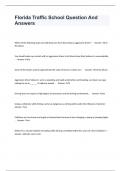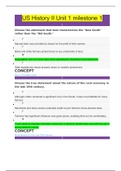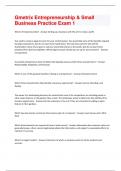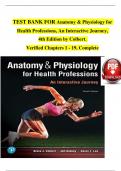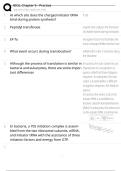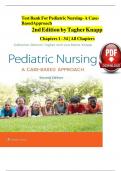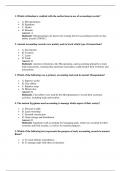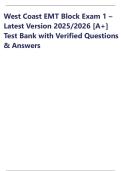BRM-II Summary – Exam 2
Course name: Business Research Methods II - Qualitative
Vrije Universiteit Amsterdam
Academic year: 2020/2021
Period: 2.5
Course code: E_IBA2_BRM2
Course coordinator: Lauren Waardenburg
Assessment: written exams (2 x 25% = 50%), Team research paper (40%) + participation
activity (submissions; 10%)
Materials
• Merriam, S. (2014). Qualitative research: A guide to design and implementation (3rd
ed.). Hoboken: Wiley. (Chapter 1, Appendix)
• Welch, C., Marschan-Piekkari, R., Penttinen, H., & Tahvanainen, M. (2002).
Corporate elites as informants in qualitative international business research.
International Business Review, 11(5), 611-628.
• Tracy, S. J. (2013). Qualitative research methods. UK: Wiley-Blackwell. (Chapter 9)
• Kelle, U. (1997). Theory building in qualitative research and computer programs for
the management of textual data. Sociological research online, 2(2), 1-13.
• Pratt, M. G. (2009). From the editors: For the lack of a boilerplate: Tips on writing up
(and reviewing) qualitative research. Academy of management journal, 52(5), 856-
862.
Exam focus:
• Recognize the theory supporting the main elements of the iterative nature of
conducting qualitative research process
• Describe and explain the most important qualitative research strategies and
approaches
• Describe and explain the major components of the research process
• Can explain the theoretical foundations of qualitative research
, GO BACK TO OVERVIEW BUTTON
Overview
Week Lectures Additional notes Preparati
on
Week 4 L4: data analysis: manual Tutorial 4: interview Tracy
(16) and computer supported question (2013),
Module D
Kelle
(1997)
Week 5 Tutorial 5: practicing
(17) observation
Week 6 Tutorial 6: analyzing
(18) qualitative data
Week 7 L5: reporting qualitative Tutorial 7: analyzing Pratt
(19) research and writing up qualitative data using (2009),
Module E computer software
Merriam
(2014)
Week 8 L6 Ethics & Research Tutorial 8: questions and Welch et
(20) Sensitivity feedback on data al., (2002)
Module F analysis
Tutorial 9: addressing
the challenges of
‘writing up’
Week 9 Practice exam Covers week 4 till 8
(21) Exercises
Module D
Module E
Module F
, GO BACK TO OVERVIEW BUTTON
Module D - Data Analysis: Manual and Computer Supported
- Lecture 4: Data Analysis: Manual & Computer Supported
- Tutorials
- Tracy (2013)
- Kelle (1997)
Lecture 4: Data Analysis: Manual & Computer Supported
Lecture 4.1: 1 hour clip
(https://av-media.vu.nl/mediasite/Play/ee9daa498cd643a0809766750d5aa6791d)
The Qualitative Research Process
This lecture is concerned with preparing raw data, primary open coding, creating a codebook,
and Secondary Hierarchical Coding
Making Sense of a Lot of Data
• Computers are useless
• You are the instrument (you have to collect and interpret data yourself)
•
, GO BACK TO OVERVIEW BUTTON
Steps for Qualitative Analysis
1. Prepare the raw data
2. Primary Cycle
- Immerse yourself in the data (get a cup of coffee and read through your
data/interviews:
“what is going on?”)
- Create “open” codes Create a codebook Secondary Cycle
3. Create hierarchical category's
4. Revisit the scholarly literature on your topic to focus rest of analysis
5. Create relationships between categories’
- Conceptual model
1. Preparing Raw Data
Assign pseudonyms to names of specific people in your data
• Organizethedataintheorderyouplantoanalyze
• Chronologically
• By type (interview vs. observation)
• By source (employee vs. manager)
(case 1 vs. case 2) (key informants vs. other informants)
(https://docs.google.com/document/d/1H9Toojea75Q84j1dCl39B1alDsAsiL9paX6A68m7zB
Q/edit)
2. Primary Cycle: open coding (Tracy, 2013)
Start open coding (label)
• Identifying data as belonging to or representing some type of phenomenon
• Codes are words and short phrases (label) that captures that salient attribute of
your data
• Remain descriptive (write what you have read)
• The goal is to detail “who”, “what”, “where”
How to: “Open Coding”
• Unit of coding: sentence-paragraph
• Creating code: stick closely to what the participants of your data said/what you saw
in your observations- in vivo codes
• Constant Comparative Method: Compare new uncoded data with your old codes-
try to apply the same code if it “fits” to new data.
• Simply describe- do not yet interpret!
• Want to capture participants meanings
• Open codes are the raw ingredients for your eventual interpretation
3. Create a Codebook
Your codebook is your map to help you navigate through your coded data
Your codebook is your evidence and your interpretation that gets into your paper
You can use excel or Atlas Ti

